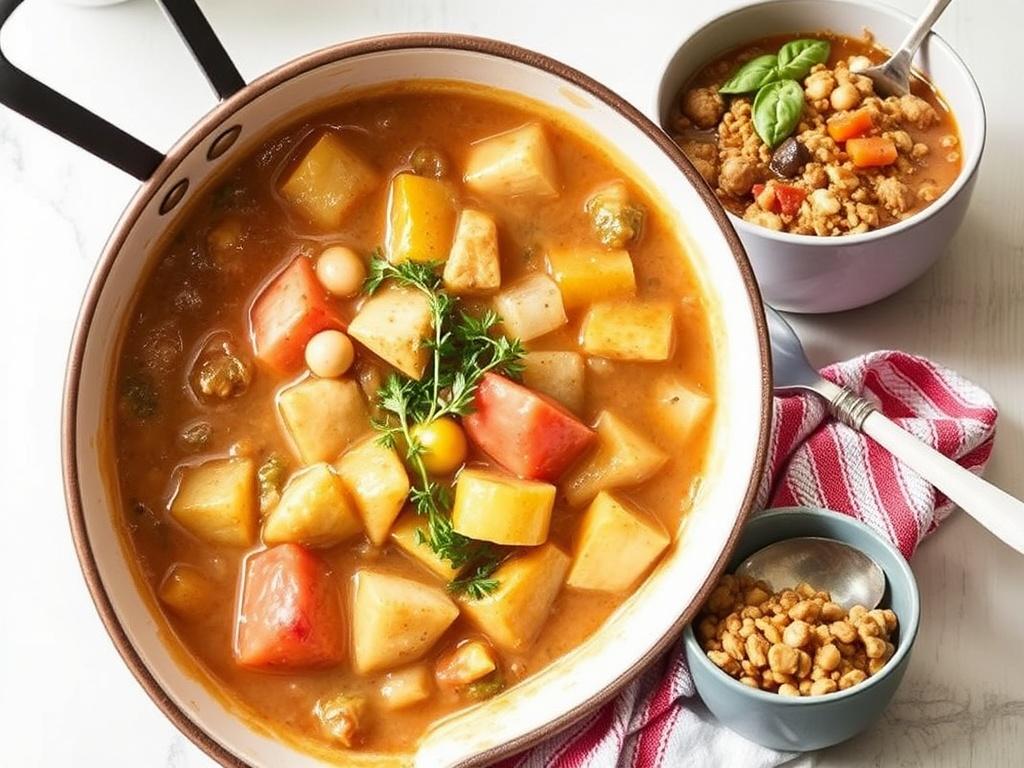There is something almost ritual about the way a pot simmers on a chilly evening, the kitchen filling with warm, savory smells that feel like a hug. Cozy Winter Stews and Casseroles pull together humble ingredients and long, gentle cooking to produce food that is both practical and indulgent. These dishes are not just about feeding the body; they steady the rhythm of a winter week, offering leftovers that taste better each day. Below I explore how to build deeply flavored stews and layered casseroles, share pantry tricks, and offer recipes and serving ideas that make home feel warmer.
Why Stews and Casseroles Work for Winter
Stews are the essence of slow cooking: tougher cuts of meat and dense vegetables transformed into silk and softness through time and low heat. Casseroles, on the other hand, are about composition, making one baking dish do the work of an entire meal. Both formats embrace economical ingredients and scale easily for family dinners or freezing. They also reward patience: flavors meld, textures harmonize, and what starts as simple components finishes rich and complete.
From a practical standpoint, these dishes are ideal for busy lives. Put a pot on in the morning, and you get hours of unattended flavor development. Bake a casserole and leave it to rest while you wrap gifts or take a walk, then come back to a golden top and a fragrant kitchen. This low-effort, high-reward aspect is why stews and casseroles have anchored winter menus across cultures.
Key Ingredients and Pantry Essentials
Stocking a winter pantry means thinking ahead about the building blocks of flavor. A good stock or broth is the backbone of a winter stew; if homemade isn’t possible, a quality low-sodium store-bought version is fine. Canned tomatoes, dried beans, and hardy grains such as barley or farro sit well in the pantry and turn casseroles into complete meals.
Herbs and aromatics deserve their own shelf space: onions, garlic, bay leaves, and thyme elevate the simplest pot. A jar of preserved lemons, good mustard, and an assortment of vinegars can brighten long-cooked dishes. Don’t forget butter and olive oil for sautéing, and a splash of table wine or sherry for deglazing pans and adding depth.
Here is a concise pantry checklist to keep you ready:
- Stock or broth (beef, chicken, vegetable)
- Canned tomatoes and tomato paste
- Dried beans and lentils
- Barley, rice, and baking potatoes
- Onions, garlic, carrots, celery
- Basic spices: bay leaves, thyme, smoked paprika
- Butter, olive oil, and a cooking wine or vinegar
Building Flavor: A Layered Approach
Flavor in stews and casseroles is cumulative; each step should add something distinct. Start with browning proteins and vegetables to create caramelized bits that lift the whole dish. Deglazing with wine or stock captures those fond bits and pulls them into the sauce, so never skip this stage if you want depth.
Next, use aromatics and concentrated pastes—tomato paste or miso, for instance—to provide umami. Add your liquid but resist overwatering; a slow reduction concentrates flavor and improves texture. Finish with acid and fresh herbs at the end to brighten the sometimes-heavy mid-winter profile.
Techniques That Make the Difference
Braising, simmering, and baking bring different virtues to a winter meal. Braising is perfect for tough cuts like beef chuck or lamb shoulder: a short sear followed by gentle, moist heat yields tender, shreddable meat. Simmering suits bean-based winter stew; the even, steady heat softens legumes without falling apart when tempered correctly.
Casseroles benefit from an initial browning or sauté step as well as a restful period after baking. Resting lets the juices redistribute and often improves slicing and serving. For both formats, low-and-slow is a reliable mantra; it develops complexity without risking dryness or separation of fats.
Thickening and Texture: How to Get It Right
Texture matters as much as flavor. A thin, watery sauce feels unfinished, while overly thick stews can become cloying. Classic methods for thickening include reduction, the addition of roux, or using starchy ingredients like potatoes and beans. Another modern trick is to blend a portion of the stew and return it to the pot to thicken naturally while preserving flavor.
For casseroles, a custardy binder—milk and eggs or a béchamel—helps set fillings into a cohesive slice. Breadcrumbs or grated cheese on top add a pleasing contrast to creamy interiors. Experiment with different starches, but always taste as you go; the right texture is a balance between body and silk.
Vegetarian and Vegan Winter Options
Vegetarian casseroles and winter stews can be as satisfying as meat-based versions when built on hearty vegetables and legumes. Root vegetables, winter squash, mushrooms, and lentils supply both texture and umami. Roasting vegetables first intensifies their flavor and adds a caramelized note that stews need.
To replace meat’s savory depth, use miso, soy sauce, nutritional yeast, or a paste made from dried porcini mushrooms. Grains like farro and barley bring chew, while creamier elements such as coconut milk or cashew cream add richness. A well-made vegetarian winter stew can leave everyone content and warmed through.
Family-Friendly Casseroles and Crowd-Pleasing Ideas
Casseroles shine for feeding a crowd. Layered dishes like shepherd’s pie, baked ziti, or a chicken-and-rice bake scale well and are forgiving with timing. They’re also forgiving with substitutions, which makes them ideal when feeding picky eaters or adapting to what’s in the fridge.
A tip from my kitchen: assemble a casserole the night before and refrigerate it overnight. The flavors meld, and the top browns better because the surface has time to dry slightly. On a weeknight, simply slide it into a hot oven and set a timer—this is one of my favorite shortcuts for cozy meals with minimal last-minute fuss.
Freezer-Friendly Cooking and Batch Cooking
Winter stews and casseroles are some of the best candidates for batch cooking. Large pots of stew freeze well in portion-size containers, and assembled-but-unbaked casseroles can usually go straight from freezer to oven if thawed gently first. Freezer meals mean nights when you want comfort without the prep.
Label containers with contents and date; a small note about reheating temperature saves future headaches. Also, consider freezing components separately—stock, cooked beans, roasted vegetables—to recombine them later for fast assembly. This method maintains texture and allows more flexibility with meal selection midweek.
Simple Rules for Freezing
Cool food quickly before freezing to preserve texture and safety. Use airtight containers or heavy-duty freezer bags and remove as much air as possible. For casseroles with dairy or egg-based binders, flash-freeze the assembled dish uncovered for a couple of hours, then wrap tightly before long-term storage to prevent condensation damage.
Serving Suggestions and Sides

Stews benefit from contrasting textures: crusty bread, a simple green salad with sharp vinaigrette, or roasted Brussels sprouts all complement a dense pot of stew. Casseroles pair well with lighter sides to balance richness—think quick pickled vegetables or a citrusy slaw. Even small finishing touches, like a drizzle of good olive oil or a sprinkle of flaky salt, make a big difference.
For beverages, a bright white wine or a malty beer often pairs nicely with winter profiles. Non-alcoholic options include spiced cider or a sparkling water with a squeeze of lemon to cut through creaminess. Serving temperature matters too: always let baked dishes rest so flavors settle and the casserole slices neatly.
Recipes to Try: Classics and New Variations
Below are three recipes that capture different aspects of winter comfort: a long-simmered winter stew, an easy vegetarian casserole, and a cheesy family bake. These are starting templates; once you understand the balance of flavor, substitute freely.
| Recipe | Main Ingredients | Cook Time | Difficulty |
|---|---|---|---|
| Hearty Beef Winter Stew | Beef chuck, carrots, parsnips, barley, red wine | 3 hours | Moderate |
| Root Vegetable & Lentil Casserole | Lentils, sweet potato, parsnip, tomato, thyme | 1 hour 15 minutes | Easy |
| Creamy Chicken and Rice Bake | Chicken thighs, rice, mushrooms, cream, cheddar | 1 hour 20 minutes | Easy-Moderate |
Hearty Beef Winter Stew (Outline)
Cut beef into generous cubes and season well. Brown in batches, then remove and sauté onions, carrots, and parsnips until soft. Stir in tomato paste, add wine to deglaze, return beef, cover with stock, and add barley and bay leaf. Simmer gently until beef is tender and barley plump, then finish with parsley and a splash of vinegar.
This stew benefits from overnight resting; flavors settle and the texture improves. Serve with thick-cut bread and a simple mustard butter for spreading. It’s one of those recipes that feels like an event but is mostly waiting time.
Root Vegetable & Lentil Casserole (Outline)
Roast a selection of root vegetables until browned, then layer them with cooked lentils and a lightly seasoned tomato-cream mixture in a baking dish. Top with breadcrumbs mixed with herbs and olive oil, then bake until the top is golden and the filling bubblеs. It’s an excellent vegetarian anchor for a family meal and freezes well for future quick dinners.
When I first tried this, I doubled the herbs and added a scattering of toasted walnuts on top, which introduced a lovely crunch. Little adjustments like that personalize a recipe and make it memorable.
Common Mistakes and How to Avoid Them
Avoid over-salting early; flavors concentrate as liquids reduce, and it’s easier to add salt at the end. Similarly, under-browning proteins results in a flatter flavor profile. Take time at the beginning to develop color and fond for the best outcome.
Overcooking delicate vegetables is another frequent error. Add soft vegetables later in the simmering process to retain texture. Finally, don’t rush the resting period for both stews and casseroles; patience pays off in texture and flavor integration.
Tools Worth Investing In
A heavy-bottomed Dutch oven is the workhorse for stews: it holds heat evenly and goes from stovetop to oven. For casseroles, a sturdy baking dish with even heat distribution prevents hotspots and ensures a uniform bake. A good chef’s knife and a reliable wooden spoon make prep and cooking smoother and more enjoyable.
Slow cookers and pressure cookers also have their place—use a slow cooker when you want hands-off comfort and a pressure cooker to speed up long braises without sacrificing tenderness. Each tool brings a different convenience and texture, so choose based on time and desired result.
Seasonal Variations and Global Inspirations
Stews and casseroles adapt beautifully to seasonal produce and international flavors. In autumn and winter, add squash, apples, or late-season greens for variety. Borrow techniques and seasonings from global cuisines—Moroccan spice blends, French bourguignon methods, or Japanese miso-rich stocks—to reinvent familiar frameworks.
One of my favorite experiments paired kimchi with pork shoulder in a slow braise, finishing with a ribbon of sesame oil. The cultural crossover created a vibrant, comforting bowl that surprised everyone at the table. Small twists like these keep a winter menu lively and new.
Planning a Week of Cozy Meals
Map out two large pots of stew and one casserole for the week to minimize cooking time while maximizing variety. Use one night for a big batch of beans or braised meat that can become tacos, shepherd’s pie, or a salad topper later. Rotate sides—roasted greens, simple salads, and different breads—and you’ll never get bored.
Prep tasks such as chopping a week’s worth of mirepoix or roasting a tray of vegetables on Sunday shorten daily work. Store prepped items in labeled containers so you can combine components quickly when hunger strikes. This approach turns winter cooking into a manageable, even joyful routine.
Stews and casseroles are more than seasonal staples; they are a way to gather, slow down, and savor both food and company. With a few pantry staples, basic techniques, and willingness to experiment, winter becomes a season of built-up flavor and simple pleasures. Try a new recipe, tweak it to your taste, and notice how these dishes anchor long evenings and busy weeks alike.
